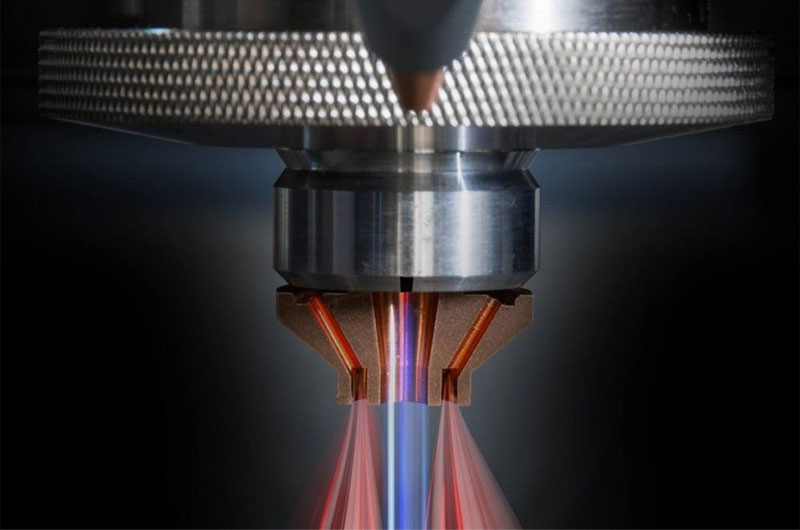The role of assist gases (typically oxygen, nitrogen, and air) in laser cutting is equally vital in determining cut quality, speed, edge finish, and cost-effectiveness.
The selection of the appropriate assist gas directly affects not only the outcome of the cut but also the overall productivity and profitability of the process.
The Role of Assist Gases in Laser Cutting
Assist gases serve multiple functions in the laser cutting process:
- Blowing away molten material from the kerf (cut line).
- Protecting the lens from spatter and fumes.
- Enhancing the cutting speed through chemical reactions (in the case of oxygen).
- Affects the quality of the cut edge and determines whether additional finishing is needed.
Selecting the appropriate assist gas involves factors such as the type and thickness of the material, required edge quality, cutting speed, post-processing needs, and overall cost.
Oxygen: The Reactive Gas
Characteristics:
- Reacts exothermically with metal during cutting.
- Typically used at pressures of 0.5–6 bar.
- Most commonly paired with CO₂ or fiber lasers when cutting carbon steels.
Advantages:
- Increased cutting speed for thicker carbon steels due to the exothermic reaction that adds heat to the process.
- Lower gas consumption than nitrogen, especially for thicker materials.
- Effective on mild steels, even up to 25 mm thick.
Limitations:
- Produces oxidized (burned) edges that may require secondary cleaning or grinding.
- Not suitable for non-ferrous metals like aluminum or stainless steel.
- Can create heat-affected zones (HAZ), which may affect downstream processes like painting or welding.
Applications:
- Cutting mild steel and structural steel where edge aesthetics are less critical.
- Heavy-duty industrial parts, brackets, or components that undergo further processing.
Nitrogen: The Inert Gas
Characteristics:
- Does not react with molten metal.
- Used at high pressures, often between 8–20 bar, or even higher for thick plates.
- Often paired with fiber lasers for high-precision cuts.
Advantages:
- Produces oxide-free, clean edges ideal for cosmetic and precision components.
- Suitable for stainless steel, aluminum, and titanium.
- No post-processing needed before painting, powder coating, or welding.
Limitations:
- Higher operational cost due to high pressure and consumption.
- Cutting speed may be slower for thick carbon steels compared to oxygen.
- Requires large storage tanks or on-site nitrogen generation for consistent supply.
Applications:
- Cutting stainless steel panels, aluminum signs, medical devices, and electronics enclosures.
- Any application where edge quality and surface integrity are critical.
Air: The Budget-Friendly Hybrid
Characteristics:
- Made up of approximately 78% nitrogen, 21% oxygen, and 1% other gases.
- Can be used at medium to high pressures (5–12 bar) with a compressed air generator.
- Offers a middle-ground between oxygen and nitrogen in terms of performance and cost.
Advantages:
- Significantly lower cost—no need to purchase bottled gas.
- Sufficient cutting speed for thin to medium sheet metals.
- Offers acceptable edge quality for many general-purpose applications.
Limitations:
- The presence of oxygen can cause slight oxidation on cut edges.
- Not ideal for very thick or high-finish parts.
- Requires dry, oil-free compressed air to avoid contamination or equipment wear.
Applications:
- Cutting thin stainless steel, aluminum, and mild steel where cost efficiency outweighs finish quality.
- Ideal for prototyping, job shops, and general fabrication.
Comparing the Three Gases
| Parameter | Oxygen | Nitrogen | Air |
|---|---|---|---|
| Reactivity | Reactive | Inert | Partially reactive |
| Cutting Speed (mild steel) | Fast (especially thick) | Moderate | Moderate |
| Edge Quality | Oxidized | Clean, shiny | Slightly oxidized |
| Operating Pressure | Low to moderate (0.5–6 bar) | High (8–20+ bar) | Medium (5–12 bar) |
| Material Suitability | Mild steel | Stainless, aluminum | General-purpose |
| Cost | Moderate | High | Low |
| Post-processing | Often required | Minimal | Sometimes required |
How to Select the Right Assist Gas
When selecting the appropriate assist gas, consider the following:
- Material Type
- Use oxygen for mild steel, especially when cutting thick sections.
- Use nitrogen for stainless steel, aluminum, and non-ferrous alloys.
- Use air for cost-effective cutting of general-purpose metals.
- Material Thickness
- Oxygen performs better on thicker materials.
- Nitrogen and air are best for thin to medium sheets (typically under 6 mm).
- Edge Quality Requirements
- Choose nitrogen for premium edge finish.
- Use oxygen or air where aesthetic or oxidation isn’t a concern.
- Post-processing Plans
- If the part will be welded or painted, avoid oxidized edges—go with nitrogen.
- For structural parts, oxidized edges may be acceptable.
- Cost and Productivity
- If cutting large volumes and need cost control, consider switching to air.
- For precision and high-value components, invest in nitrogen.
Conclusion
The choice of assist gas in laser cutting is far more than a technical detail—it is a strategic decision that influences cutting quality, efficiency, and total production cost. Oxygen, nitrogen, and air each provide distinct advantages based on your material properties, production objectives, and budget constraints.
- Use oxygen for thick mild steel and high-speed cuts with acceptable oxidation.
- Use nitrogen when edge quality and cleanliness are critical.
- Use air when cost savings matter more than perfection.

